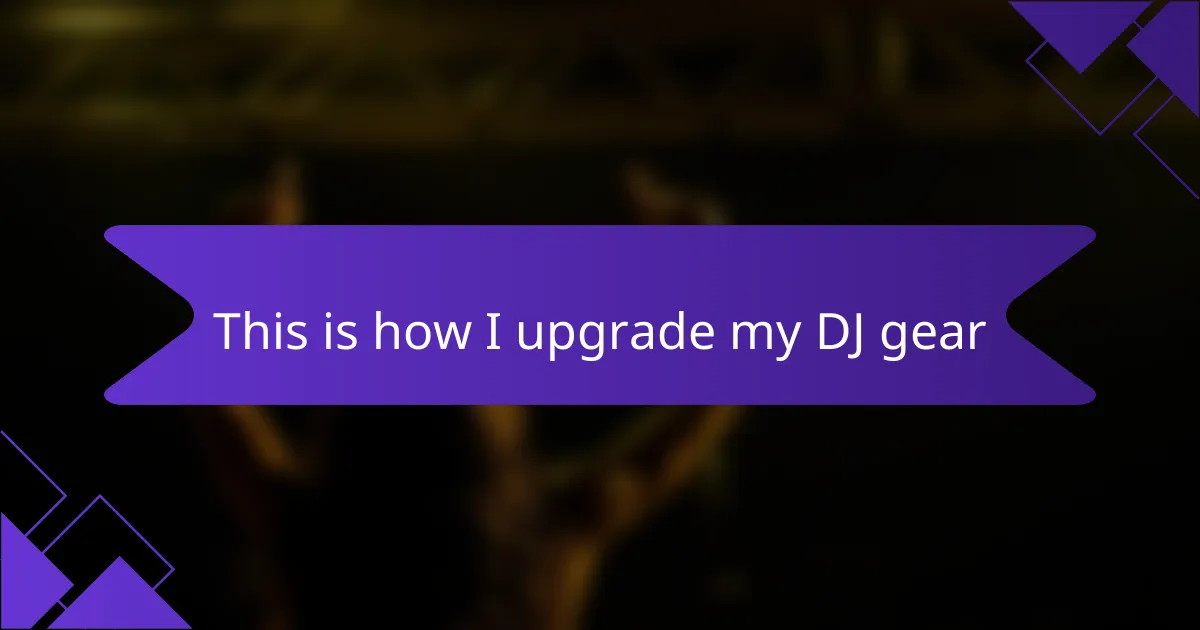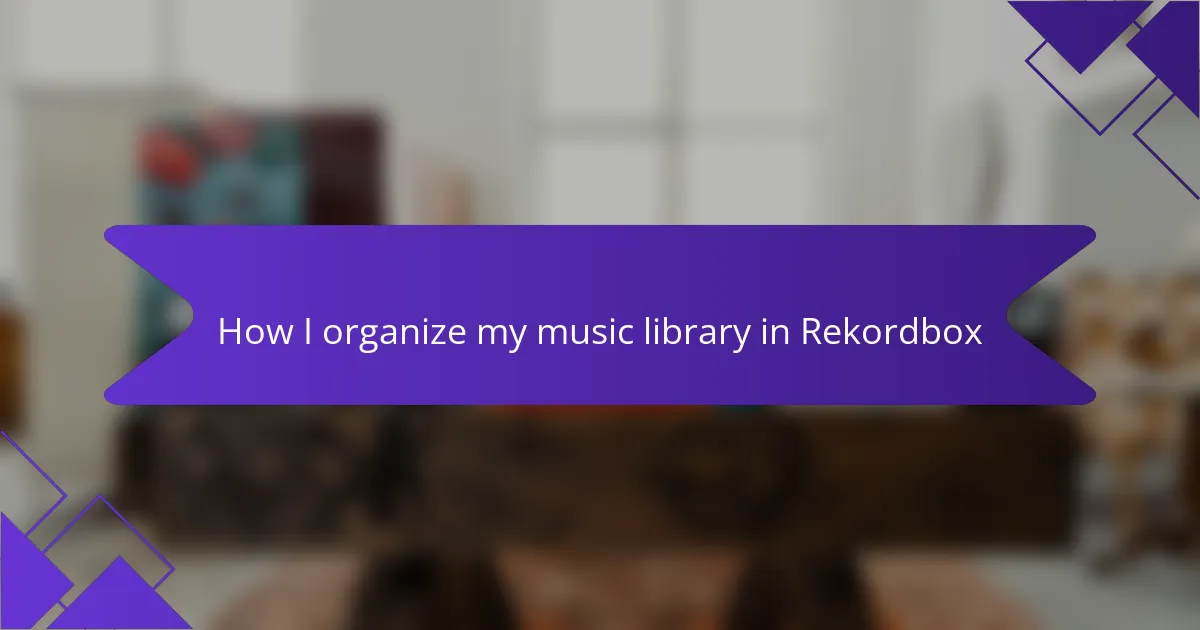Key takeaways
- Reading the crowd’s energy is essential for effectively handling song requests during DJ performances.
- Setting clear boundaries and communicating limits helps manage audience expectations and maintain the performance flow.
- Blending audience requests into the set creatively can enhance the experience and keep the energy alive.
- Engaging with the crowd through acknowledgment and improvisation can create memorable moments during performances.
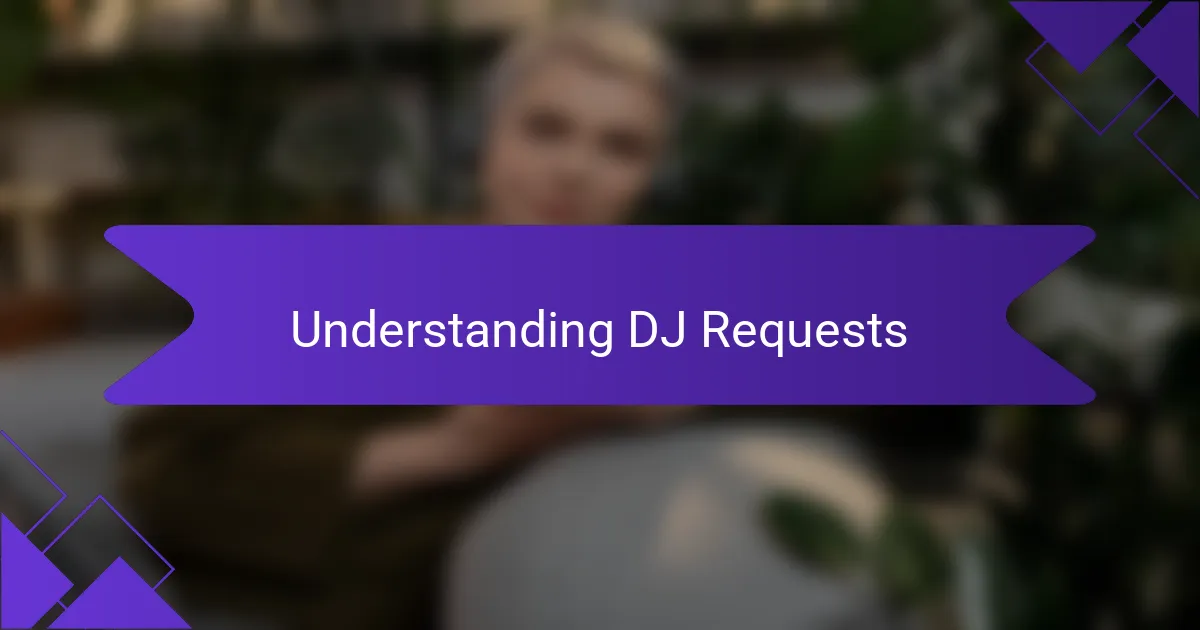
Understanding DJ Requests
Understanding DJ requests can be both a rewarding and challenging part of the gig. I’ve often found that requests can enhance the experience for the audience, creating a sense of connection. However, they can also pose dilemmas—especially when the timing isn’t right or the request doesn’t fit the vibe. For instance, I once received a request for a slow ballad during a high-energy dance set. It taught me the importance of reading the room while staying considerate of the person making the request.
To navigate this effectively, I keep a few key strategies in mind:
- Read the Crowd: Gauge the energy and mood before accepting requests.
- Set Boundaries: Politely communicate your limits on taking requests.
- Use Personal Touch: Acknowledge the requester; sometimes a simple “Great choice!” is enough.
- Curate the Set: Blend requests into your planned set where appropriate to keep the flow.
- Have Backup: Always have a few tracks that you know are crowd-pleasers in your arsenal.
By finding a balance, I’ve learned to appreciate requests while maintaining the overall atmosphere of my performances.
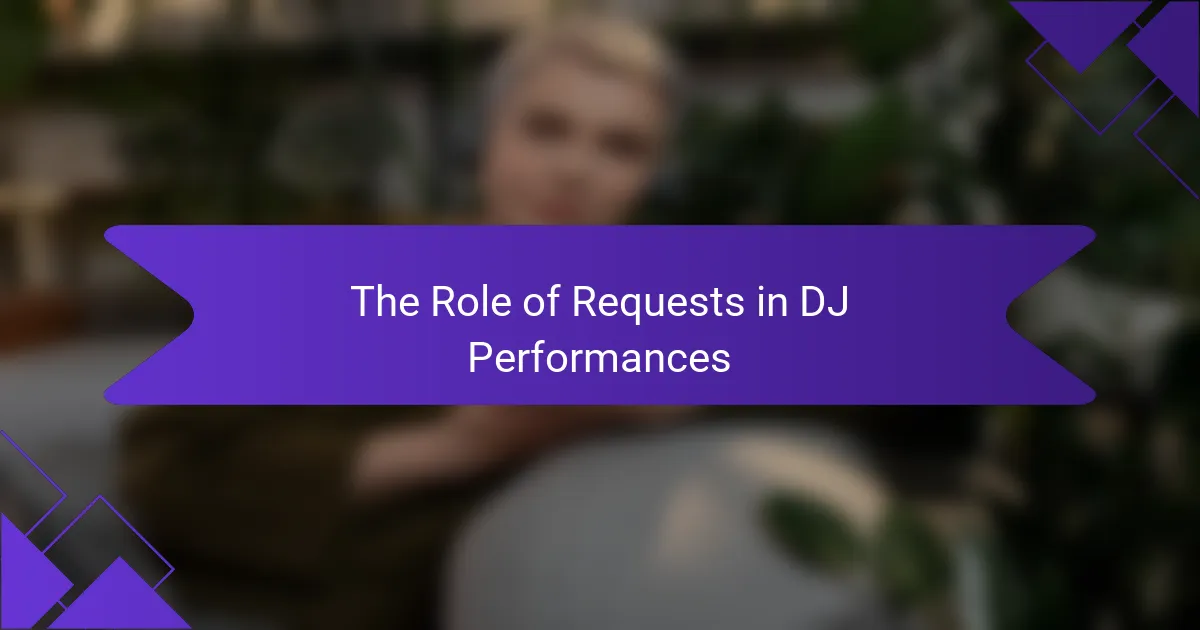
The Role of Requests in DJ Performances
The Role of Requests in DJ Performances
When I perform, requests play a significant role in shaping the vibe of the event. They can enhance the connection between me and the crowd, creating a more interactive and engaging atmosphere. I remember one party where a guest requested a song that wasn’t on my playlist. Sensing the moment, I quickly pulled it up, and the energy in the room skyrocketed. It was a reminder that these requests aren’t just about the music; they’re about understanding the crowd’s mood.
However, balancing requests with the flow of a set is crucial. There are times when a requested track might disrupt the energy I’ve been carefully building. It’s all about reading the room, knowing when to integrate those requests, and sometimes, when to politely decline. This dance of interaction adds depth to my performances, turning them into memorable experiences for everyone involved.
| Situation | Response |
|---|---|
| Popular Request | Integrate it into the set |
| Off-Theme Request | Politely decline or suggest another |
| First-Timer Request | Make an exception for crowd engagement |
| Multiple Requests | Prioritize based on crowd reaction |

Strategies for Managing Requests
Managing requests during a performance is an art that I’ve refined over time. One effective strategy is to read the crowd’s energy before engaging with requests. I recall a night when I was spinning upbeat tracks, and someone shouted for a more subdued song. I quickly assessed the vibe and gently explained that it wasn’t quite the right moment. It’s crucial to ensure that the momentum of the set remains intact while being respectful of the request.
Setting clear boundaries is another essential strategy. I’ve found that communicating my limits upfront can prevent awkward moments later. For example, I usually inform the crowd at the start of my set about the types of songs I’d love to hear while letting them know that I might not be able to play everything. This approach not only manages expectations but also fosters an understanding relationship with the audience.
Finally, blending requests into my curated set can create unique moments that keep the energy flowing. I once had a guest request a lesser-known remix, which I seamlessly integrated into a popular track. The surprise on the crowd’s faces was priceless. It’s about finding that sweet spot between flexibility and maintaining the rhythm of the night. This balance makes every performance feel special and ensures that everyone leaves with great memories.
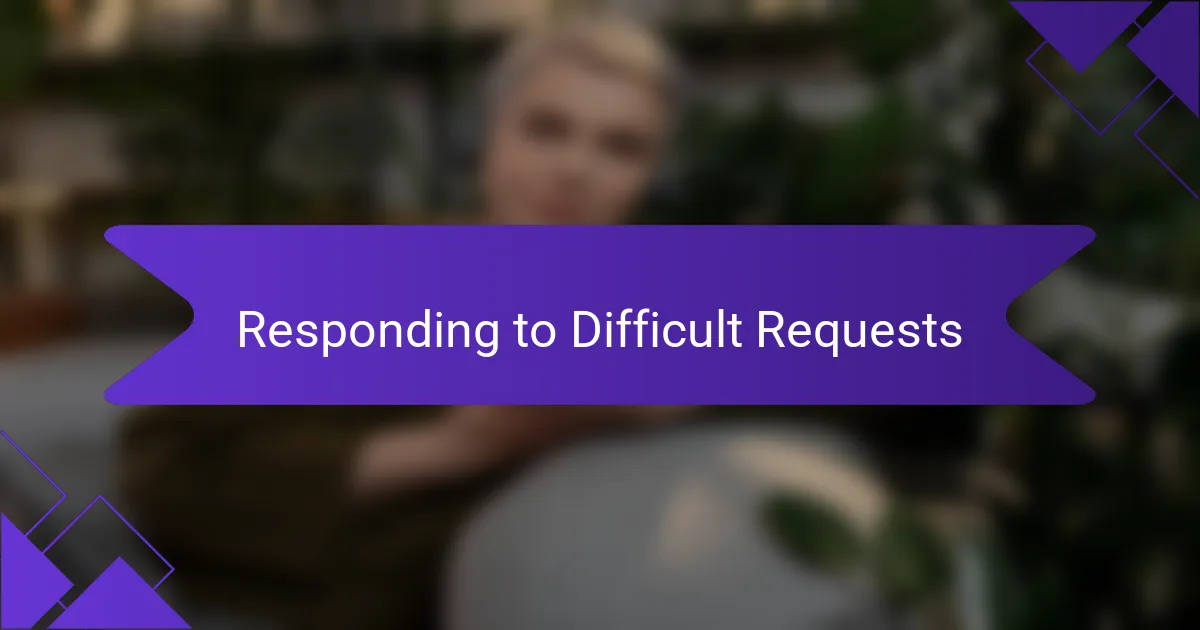
Responding to Difficult Requests
When faced with difficult requests during a performance, I always prioritize maintaining the energy of the crowd. For instance, if someone asks for a song that’s not fitting the vibe, I gently explain that I want everyone to have the best experience possible. It’s all about balancing the needs of the crowd with individual requests.
I also find it helpful to acknowledge the request and redirect the attention. For example, I might say, “I appreciate your choice, and while that song isn’t in the playlist tonight, how about I spin something similar that’ll keep everyone dancing?” This approach not only respects the individual’s wish but also keeps the atmosphere lively. Ultimately, my goal is to ensure everyone leaves happy.
Here’s a straightforward comparison of how to handle difficult requests:
| Situation | Response Strategy |
|---|---|
| Song not fitting the vibe | Acknowledge, suggest an alternative |
| Request for a genre I’m not playing | Redirect to similar songs |
| Specific song not in the playlist | Explain the situation, offer a crowd-pleaser |

Techniques for Engaging the Audience
When it comes to engaging the audience, I believe that creating a connection is paramount. During one of my performances, I noticed a group of friends eagerly dancing and enjoying the night. They began requesting songs that were significant to them, and I took the time to acknowledge them with a smile. The moment I played their request, the entire mood elevated. Isn’t it fascinating how music can resonate with personal memories, making the night even more special?
Another technique I employ is reading the crowd—not just in terms of energy but also in emotions. For example, there was a time when I felt the crowd’s excitement wane, so I circulated my attention around the requests. I engaged with someone who requested a familiar classic. As I played it, I noticed a ripple of joy sweeping through the audience, pulling them back into the experience. It’s incredible how attuning ourselves to the crowd can create such moments of joy.
I’ve also learned that improvisation can be key in maintaining engagement. Just recently, I had a guest request an obscure track during a peak moment. Instead of dismissing it, I quickly mixed it into a mashup, blending it with a current hit. The surprise and excitement on everyone’s faces were unforgettable. It made me reflect—how often do we miss opportunities for spontaneity in our performances? By being flexible and open to the unexpected, I’ve found that the crowd not only stays engaged but often leaves with memories that last long after the music stops.
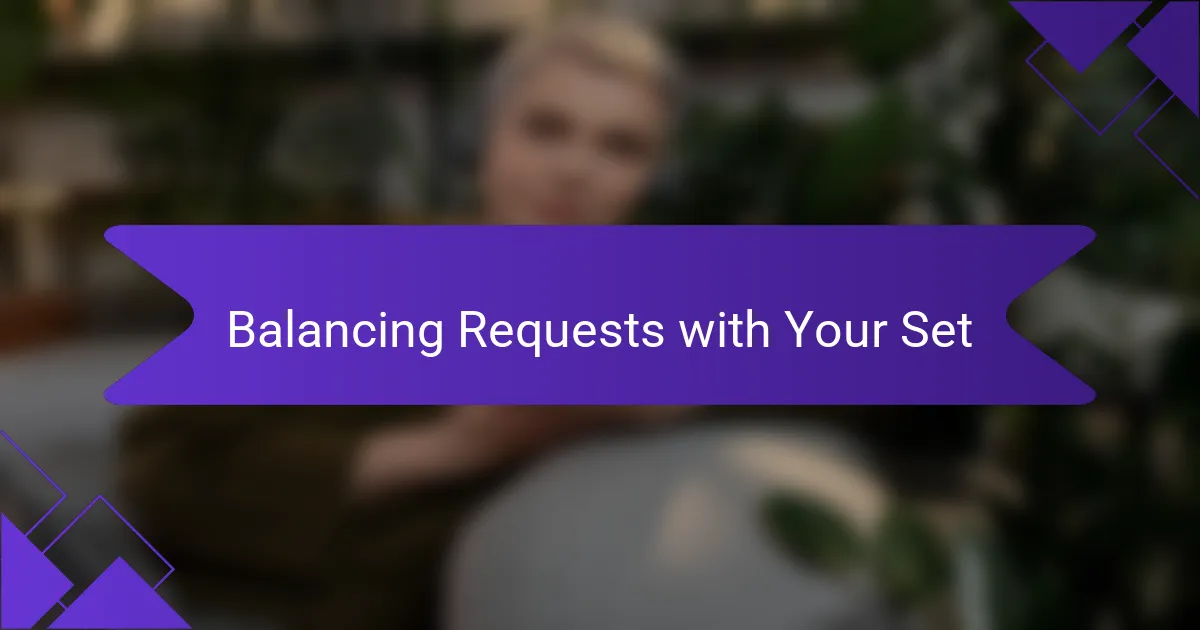
Balancing Requests with Your Set
When I’m in the middle of a high-energy set, requests from the crowd can be a double-edged sword. I remember one night, a guest approached me with a heartfelt plea to play their favorite song; it turned out to be a track that would have completely shifted the vibe. I took a moment to assess the energy, and instead, I mixed in a familiar tune from the same artist, which kept the momentum going while still acknowledging their request.
Balancing requests is all about maintaining the flow of the performance. Here are some strategies that have worked for me:
- Understand the Crowd: Stay aware of the audience’s reaction; their energy will guide your decisions.
- Set Limits: I often let my audience know that while I appreciate requests, there’s a flow I need to maintain during my set.
- Blend Favorites: I try to incorporate requested songs into my mixes at appropriate moments, avoiding sudden tonal shifts.
- Create a Playlist: If I have a few set songs ready, I can easily weave in audience favorites that fit.
- Acknowledge Requests: A simple nod or a smile can go a long way; it makes the guests feel involved without derailing the performance.

